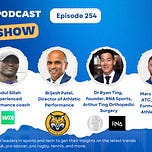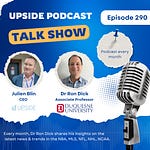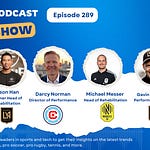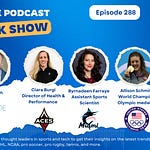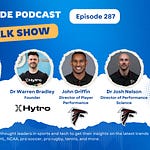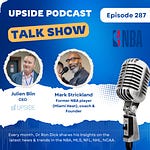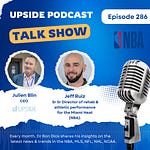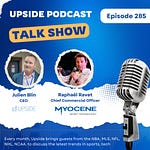This week we have the honor to interview a group of experts in the science of movements in elite sports.
Abdul Sillah, experienced performance coach. Abdul has worked with Serena Williams, Naomi Osaka.
Brijesh Patel, Associate Athletic Director, Director of Athletic Performance at Quinnipiac University (NCAA).
Dr Ryan Ting, founder of RNA Sports. He is also an MD, MPH, and Medical Director at Arthur Ting Orthopedic Surgery and Sports Medicine.
Marc Drobenko, ATC, and DNSP, Former Assistant Athletic Trainer in college and professional sports.
You can watch the video interview below by clicking on the Youtube link. You can also listen to the audio interview by clicking on the link at the top of the page:
📝Show Notes: Through this interview, we touched on the following questions:
How has the science of movement evolved in the last 5–10 years across elite sports like the NBA, NHL, and tennis — and what’s driving that evolution?
What are the most important biomechanical or neuromuscular factors practitioners should assess to optimize movement quality and reduce injury risk?
How do you approach movement retraining or re-patterning with elite athletes who already perform at a high level but have asymmetries or inefficiencies?
Which tools, technologies, or methodologies are you most excited about right now for evaluating or enhancing movement in elite settings?
How do you effectively communicate complex movement data to coaches and athletes — and ensure it drives meaningful change in training or performance?
You can read the full transcript of the podcast interview located at the top of this blog post.
Here are some of the best quotes of our conversation with Abdul, Ryan, Brijesh and Marc:
Q1. How has the science of movement evolved in the last 5–10 years across elite sports like the NBA, NHL, and tennis — and what’s driving that evolution?
Brijesh Patel:
“Over the last five to ten years, we've seen a massive shift in how we approach keeping players healthy. That’s really what's driving the evolution in movement science — job security. Sports is big business, and athletes are the assets. If they're not on the field, the team suffers — and so does the organization. Practitioners are constantly looking for ways to protect those assets. We’ve gone from using movement screens like FMS and Y-Balance to more advanced tools like force plates, high-speed cameras, and GPS monitors that quantify external loads and the cost of movement. But what we often forget is the art of coaching — the feel, the eye test, the relationships with athletes. Sometimes, the obsession with numbers can blind us to what we’re actually seeing. Athletes start to game the system — cheating a jump test or adjusting their sprint to hit a better number, even if it’s not the most efficient or safe way to move. That’s why it has to be a blend of technology and coaching artistry.”
Dr Ryan Ting:
“In Silicon Valley, everything is data-driven. So the demand from youth athletes and parents has grown — they want to know how to jump higher, run faster, and prove it objectively. But while we’ve collected more data and developed more technologies over the last decade, I still think we’re missing the mark in how well we translate that data. We talk a lot about performance numbers, but we don’t focus enough on quality — on biomechanics and body control. That’s where the real injury prevention happens. We need to stop treating data like the final answer. It’s just a piece of the puzzle.”
“At the youth level, the stakes might not be job security like it is in the pros — it’s roster security. Parents are desperate to get their kids on varsity or in front of scouts. But when you prioritize explosive performance metrics without checking movement mechanics and body control, you're setting kids up for chronic injuries. I've always said — the body mechanics and proprioception have to come first. Otherwise, no matter how fast or high they go, it’s just a matter of time before the wheels come off.”
Abdul Sillah:
“We’re becoming too dependent on lab data and not enough on our own eyes. The eye doesn’t lie. We spend the most time with these athletes — we know their bodies, their fatigue levels, and their limits better than anyone sitting in a lab. The last five to ten years, I’ve seen too many practitioners lean on tech and lose that personal connection. But that’s where the real insights come from. I trust myself more than any device — and so do my athletes. That trust is earned over time on the field, not in front of a screen.”
Marc Drobenko:
“Just to add a little bit on top of what Coach B and Dr. Ryan said, in regards to data — it helps decision-making to a point, but that’s where the artistry of coaching comes in. One coach might take the same data and go one way, while another coach uses it in a completely different way that’s more effective for that athlete or team. I always go back to something I heard from Dr. Craig Liebenson in L.A.: ‘You have to move well, then move often.’ If you do both, and then load those patterns correctly, you’re going to build a robust system”.
“What I’ve been focusing on at the higher levels is: how do athletes move under extreme stress? Do their patterns change? Does their breathing change? Where do their eyes go? I’ve seen it in huddles — elite players have calm breathing and focused eyes. Players who aren’t performing at that same level? Their eyes are all over the place. They’re distracted. There’s a clear connection between how athletes move and how they manage stress. The best movers are often the most composed — and vice versa”.
Q2. What are the most important biomechanical or neuromuscular factors practitioners should assess to optimize movement quality and reduce injury risk?
Marc Drobenko:
“When I assess an athlete, I’m looking at their firing patterns — especially in the posterior chain. It might sound simple, but you’d be surprised how many elite performers have dysfunctional firing sequences. For example, when a person lies face-down and lifts a leg, the first muscles that should fire are the glute max and the hamstring. Instead, I’ll often see the lumbar spine fire first, then the wrong muscles in the wrong order. These imbalances tell me how unstable their pelvis might be and how well — or poorly — they can coordinate complex movements. If they can’t stabilize the pelvis, how can they control the hips in rotation, acceleration, or deceleration? So before they even hit the field or the gym, I start on the table and try to get their sequencing right — so we can hand them off to a performance coach like Brijesh in a much better place.”
Brijesh Patel:
“My first question with any movement assessment is: can the athlete even get into the position we’re asking for? If they can’t achieve the position — unilaterally or bilaterally — that tells you everything. Then I’ll ask: can you feel it? Can you feel your glute? Your big toe? Your scapula? If they can’t sense it, they can’t control it. And if they can’t control it, they can’t change it. So many athletes come in and don’t even understand how to feel their own body. But with consistent cueing and education, we help them open up that sensory feedback loop. That’s how you build better movers — not just stronger ones.”
Dr Ryan Ting:
“We talk about load management, acceleration, and deceleration — but we need to look at the mechanics under the hood. Are they overstriding? Where is their center of mass when they plant? Do they land like a gymnast or like a wrecking ball? Athletes often get injured not because of how they move forward, but because of how they absorb and control force. If you can’t handle eccentric loads properly, you’re just setting up for chronic injuries. We’ve got to stop just chasing force production and start focusing on force absorption.”
Abdul Sillah:
“There’s not much to say because they covered all grounds actually. I mean, Dr. Ryan Ting came in and basically covered the other end of it. That was really interesting, especially about changing your stride length instead of opening it up like everyone typically teaches. I had chronic hamstring issues back in my track days, especially when we went to state. It was because of that — overstriding. And that’s when I learned how to adjust my stride length. Not doing the typical long stride, but actually shortening it and learning how to maintain speed without constantly accelerating. So when Ryan mentioned that, I was like — that’s perfect. That’s exactly what I went through. It connected immediately.
Q3. How do you approach movement retraining or re-patterning with elite athletes who already perform at a high level but have asymmetries or inefficiencies?
Marc Drobenko:
“There’s a fine line between helping and over-coaching. Elite athletes often have asymmetries that actually make them great. A punter in the NFL who only kicks with one leg is naturally going to be asymmetric — and that’s okay. A swimmer who breathes only to the right? Same thing. What I care about is whether that asymmetry is causing a problem. If it’s not, leave it alone. But if it’s creating a risk or a recurring issue, then we educate. We explain the why and the how — and then we reassess. Ultimately, we’re not here to make everyone symmetrical — we’re here to make them efficient and sustainable.”
Dr Ryan Ting:
“You’re not going to walk up to a guy like Odell Beckham Jr. and say, ‘You’ve got to change how you run.’ That’s not realistic. But what we can do is refine the movement to make it more efficient — without changing the signature that makes them special. It’s like writing — everyone has a different handwriting. You don’t ask someone to change their signature, but you can help them write more clearly. That’s how we approach movement retraining.”
Brijesh Patel:
“For me, it’s about giving athletes variability — the ability to move side-to-side, to decelerate, to rotate both ways. You’re not trying to fix everything. You’re just trying to make sure they have the movement options they need to stay healthy and perform. We use isometrics, eccentrics, and sequencing to help clean up the inefficiencies — but we never take away the individuality of their movement. That’s sacred.”
Abdul Sillah:
“If you don’t catch these patterns early, by the time the athlete’s making millions, they’re locked in. You can’t walk in and start over. At that point, it’s all about education and awareness. If you’ve built trust with them, they’ll listen. But you’ve got to meet them where they are and work with their movement style, not against it.”
Q4. Which tools, technologies, or methodologies are you most excited about right now for evaluating or enhancing movement in elite settings?
Brijesh Patel:
“Honestly, my most powerful tools are my eyes and my ears. Those are the things I train every day. No device can replace what I see when an athlete walks, cuts, or jumps. That visual feedback, combined with what the athlete tells me, helps me make better coaching decisions than any tech. That said, I’d love to have access to force plates — they can confirm what I’m already seeing and make it easier to explain the ‘why’ to the athlete. But I always start with what I can see and feel.”
Abdul Sillah:
“I’ve used the gadgets — force plates, wearables, motion capture. They’re great, but what makes us special is our instinct, our creativity. You can’t automate experience. The moment the athlete starts moving, I know if something is off. That’s not something a screen can tell me before I do. And that instinct is what helps me keep athletes like Serena or Naomi healthy — because I’m watching them 24/7. I’m not sitting in a lab. I’m on the court with them. That’s what matters.”
Dr Ryan Ting:
“If we can use motion capture and joint tracking in real-time to enhance what we already know — that’s powerful. The key is: don’t let the tech replace coaching. Let it enhance it. A coach with a sharp eye doesn’t need confirmation, but the data helps communicate with others — whether it’s other staff, parents, or the athletes themselves.”
Marc Drobenko:
“Piggybacking off of what Coach Abdul said — the body tells a story. You show up to the court, and you can see it. There are times where you look at an athlete and just know something’s off. Depending on what I’m seeing — how they’re moving, their posture, their rhythm — I can predict things like, ‘That backhand might be a problem today.’ The movement speaks before the athlete does”.
“So the real tool? It’s not a force plate or a wearable. It’s your eyes. The best practitioners are the ones who’ve trained their eye over years and years. Without any words, the body language tells you what you need to know. That’s how I evaluate movement first — I watch. I listen. Then I make decisions. Technology is great, but if you can’t see what’s happening in real time with your own eyes, you’re going to miss the story that the athlete’s body is telling you.”
Q5. How do you effectively communicate complex movement data to coaches and athletes — and ensure it drives meaningful change in training or performance?
Abdul Sillah:
“My background is in psychology, not kinesiology. So for me, it’s all about communication. Every athlete — no matter how elite — has a way to reach them. You just have to listen and learn how they think. It’s not about barking orders. It’s about showing them their goal, then helping them understand what it takes to get there. I remember when Serena first started training with me, I told her: no headphones when we’re working. I needed her full attention. Fifteen years later, after winning dozens of titles, she still remembered that rule. That’s respect. That’s trust. And that’s how you get through to a champion.”
Marc Drobenko:
“With elite athletes, it’s about education, not correction. I once worked with a martial artist who had kicked thousands of times in his career. But when I pointed out that his support foot’s big toe was lifting off the ground, and asked him to keep it down, his next kick sent the bag flying — farther than ever before. He said, ‘How did you know that?’ That’s how you earn trust. You show them, not tell them. When they feel the difference, that’s when change happens.”
Dr Ryan Ting:
“If we can explain the ‘why’ behind the movement and connect it to their goals — and if we can back that up with data or immediate results — then we get buy-in. Elite athletes have egos, and they should. They’ve earned it. So we meet them with respect, and then show them how to keep what they’ve built and extend their careers. That’s how you move mountains.”
You may also like:
🔥Upside Chat with Chris Chase (Memphis Grizzlies/NBA), Dr Marco Nunez (ex LA Lakers/NBA), Dr Andy Barr (Quantum Performance), Derek Millender (Cleveland Cavaliers /NBA).
This week we have the honor to interview again a group of NBA sports performance executives:
🔥Upside NHL Group Chat with Alexi Pianosi (Colorado Avalanche), Chris Stackpole (NJ Devils), Adam Douglas (Penguins)
This week we have the honor to interview a group of NHL sports performance executives to talk about the latest trends in the world of sports performance, load management, sleep/recovery management, rehabilitation and data & wearable tech integration, and mental performance in the NHL.
🔥Upside NCAA Group Chat with Eric Renaghan (University of Miami/NCAA), Drew Lukes (Duke University/NCAA), Dr John DeWitt (Rice University) On The Transfer Portal, NIL, AMS, Nutrition And More
This week we had the honor to interview a group of NCAA sports performance experts.

